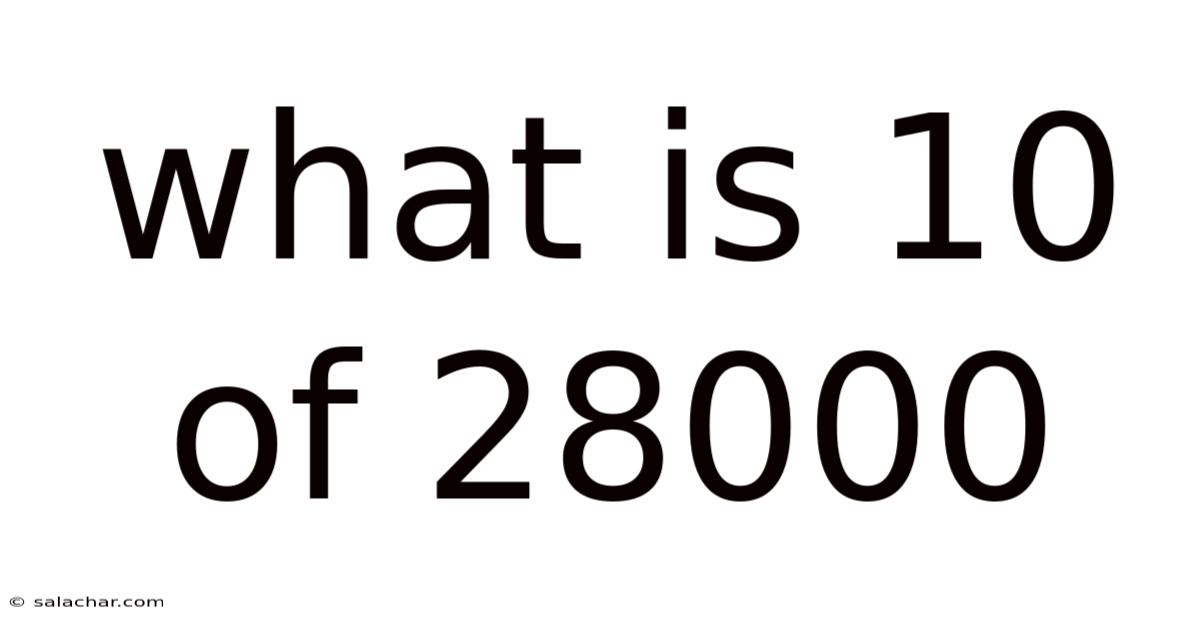What Is 10 Of 28000
salachar
Sep 13, 2025 · 4 min read

Table of Contents
What is 10% of 28,000? A Comprehensive Guide to Percentages and Their Applications
Finding 10% of 28,000 might seem like a simple calculation, but understanding the underlying principles of percentages is crucial for various applications in everyday life, from calculating discounts and taxes to understanding financial reports and statistical data. This article will not only answer the question directly but also delve into the broader concept of percentages, providing you with the tools to tackle similar problems and a deeper appreciation of their significance.
Understanding Percentages
A percentage is simply a fraction or a proportion expressed as a number out of 100. The term "percent" comes from the Latin "per centum," meaning "out of a hundred." Therefore, 10% means 10 out of 100, which can be written as the fraction 10/100 or the decimal 0.10. Understanding this fundamental concept is key to calculating percentages efficiently.
Calculating 10% of 28,000
There are several ways to calculate 10% of 28,000. Let's explore the most common methods:
Method 1: Using the Decimal Equivalent
The simplest method involves converting the percentage to its decimal equivalent and multiplying it by the given number. Since 10% is equal to 0.10, the calculation is straightforward:
0.10 * 28,000 = 2,800
Therefore, 10% of 28,000 is 2,800.
Method 2: Using the Fraction Equivalent
Alternatively, you can use the fraction equivalent of 10%, which is 10/100 or simplified to 1/10. The calculation becomes:
(1/10) * 28,000 = 28,000 / 10 = 2,800
This method highlights the underlying concept of dividing the number by 10 to find one-tenth of it. This is particularly useful for calculating 10%, 20%, 30%, and so on, as it involves simple division.
Method 3: Using Proportions
A more formal approach involves setting up a proportion. We can write this as:
10/100 = x/28,000
Where 'x' represents the unknown value (10% of 28,000). To solve for 'x', we cross-multiply:
10 * 28,000 = 100 * x
280,000 = 100x
x = 280,000 / 100 = 2,800
This method is more versatile and can be applied to calculating any percentage of any number.
Real-World Applications of Percentage Calculations
The ability to calculate percentages is essential in numerous real-world scenarios. Here are a few examples:
-
Sales and Discounts: Retail stores frequently offer discounts expressed as percentages. For instance, a 20% discount on a $50 item means you save 20% of $50, which is $10, resulting in a final price of $40.
-
Taxes: Sales tax, income tax, and other taxes are usually calculated as a percentage of the taxable amount. Understanding these percentages is crucial for budgeting and financial planning.
-
Financial Investments: Interest rates on savings accounts and loans are expressed as percentages. Calculating the interest earned or paid requires understanding percentage calculations.
-
Statistics and Data Analysis: Percentages are commonly used to represent data in charts, graphs, and reports. Analyzing these percentages allows for better understanding and interpretation of trends and patterns.
-
Grade Calculations: In academic settings, grades are often expressed as percentages, reflecting the proportion of correct answers or the overall performance in a course.
-
Tip Calculation: Calculating tips at restaurants is often based on a percentage of the total bill. A common practice is to calculate 15%, 18%, or 20% of the bill as a tip.
Beyond 10%: Calculating Other Percentages
While we've focused on calculating 10%, the methods described can be easily adapted to calculate other percentages. For example:
- 25% of 28,000: 0.25 * 28,000 = 7,000
- 50% of 28,000: 0.50 * 28,000 = 14,000
- 75% of 28,000: 0.75 * 28,000 = 21,000
For more complex percentages, the proportional method or a calculator can be helpful.
Frequently Asked Questions (FAQs)
Q: What is the easiest way to calculate 10% of any number?
A: The easiest way is to divide the number by 10. This works because 10% is equivalent to 1/10.
Q: How can I calculate percentages without a calculator?
A: For simpler percentages like 10%, 25%, 50%, and 75%, you can use the fraction equivalents and perform simple division or multiplication. For more complex percentages, you can use the proportion method or mental math techniques.
Q: What if I need to calculate a percentage that isn't a whole number, like 12.5%?
A: Convert the percentage to its decimal equivalent (12.5% = 0.125) and multiply it by the given number.
Q: Are there any online tools or calculators for percentage calculations?
A: Yes, many online calculators and tools are available to perform percentage calculations quickly and efficiently. These tools can be particularly useful for more complex calculations or when dealing with large numbers.
Conclusion: Mastering Percentages for a Brighter Future
Understanding percentages is a fundamental skill with widespread applications across various aspects of life. While calculating 10% of 28,000 is a relatively simple calculation (resulting in 2,800), the underlying principles and methods extend far beyond this specific example. By grasping these core concepts, you'll be better equipped to handle various numerical challenges, make informed decisions, and improve your understanding of quantitative information in everyday life and professional settings. From budgeting and financial planning to analyzing data and making informed purchases, the ability to work confidently with percentages is a valuable asset. Remember, practice is key to mastering this crucial skill.
Latest Posts
Latest Posts
-
What Is A Gaseous Element
Sep 13, 2025
-
Difference Between Charcoal And Coke
Sep 13, 2025
-
Christmas Ideas For Christmas Eve
Sep 13, 2025
-
Anatomy Of A Sea Snail
Sep 13, 2025
-
What Is A Medium Physics
Sep 13, 2025
Related Post
Thank you for visiting our website which covers about What Is 10 Of 28000 . We hope the information provided has been useful to you. Feel free to contact us if you have any questions or need further assistance. See you next time and don't miss to bookmark.